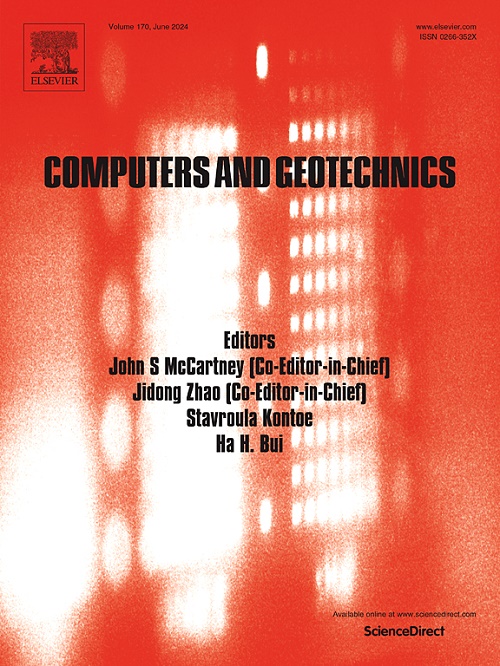A fully-resolved micromechanical simulation of piping erosion during a suction bucket installation
IF 5.3
1区 工程技术
Q1 COMPUTER SCIENCE, INTERDISCIPLINARY APPLICATIONS
引用次数: 0
Abstract
Granular fluidization phenomena such as piping erosion represent a challenge to the delicate installation process of offshore suction bucket foundations. A detailed analysis of the complex conditions in terms of soil composition, soil state, and foundation installation parameters that may lead to piping can be very demanding, if at all possible, solely by experimental means or using macroscopic continuum-based seabed models. The present paper presents a fully-resolved fluid-coupled micromechanical approach for a three-dimensional numerical simulation of the installation process of a suction bucket using the lattice Boltzmann method and discrete element method. The developed model is validated using well-established benchmarks and calibrated by means of experimental data from physical model tests on relevant scenarios focusing on the local fluidization of fixed embedded suction buckets as well as on the suction-driven installation of unrestrained buckets. The qualitative and quantitative agreement with the experimental data both endorse the proposed methodology and highlight the physical soundness of the obtained results. Thereby, the paper shows that three-dimensional analyses of relevant local scenarios at a real scale with little macromechanical model assumptions are feasible.

在吸桶安装过程中管道侵蚀的全分辨微力学模拟
管道侵蚀等颗粒流态化现象对海上吸桶基础的安装工艺提出了挑战。如果可能的话,仅通过实验手段或使用宏观连续海床模型来详细分析可能导致管道形成的复杂条件,包括土壤成分、土壤状态和基础安装参数,这是非常苛刻的。本文采用点阵玻尔兹曼法和离散元法,建立了一种全分辨流体耦合微力学方法,对吸力斗安装过程进行了三维数值模拟。所开发的模型使用完善的基准进行了验证,并通过物理模型测试的实验数据进行了校准,这些测试集中在固定嵌入式吸入桶的局部流化以及无约束桶的吸入驱动安装上。与实验数据的定性和定量一致都认可了所提出的方法,并突出了所获得结果的物理合理性。从而表明,在很少的宏观力学模型假设下,在实际尺度上对相关局部情景进行三维分析是可行的。
本文章由计算机程序翻译,如有差异,请以英文原文为准。
求助全文
约1分钟内获得全文
求助全文
来源期刊

Computers and Geotechnics
地学-地球科学综合
CiteScore
9.10
自引率
15.10%
发文量
438
审稿时长
45 days
期刊介绍:
The use of computers is firmly established in geotechnical engineering and continues to grow rapidly in both engineering practice and academe. The development of advanced numerical techniques and constitutive modeling, in conjunction with rapid developments in computer hardware, enables problems to be tackled that were unthinkable even a few years ago. Computers and Geotechnics provides an up-to-date reference for engineers and researchers engaged in computer aided analysis and research in geotechnical engineering. The journal is intended for an expeditious dissemination of advanced computer applications across a broad range of geotechnical topics. Contributions on advances in numerical algorithms, computer implementation of new constitutive models and probabilistic methods are especially encouraged.
 求助内容:
求助内容: 应助结果提醒方式:
应助结果提醒方式:


